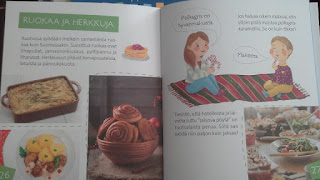 |
| Finnish Cover |
Anu S. Airaksinen 2016: My World Ruotsi
Small guide to Finland. The book covers briefly geography, arts, sports, culinary heritage and examples of Finnish dialects. Even Angry Birds are mentioned. Moomins, too, but they have been around half a century or more. They do mention the strong connection to Sweden, but Russia is totally ignored. Hmm.. I guess they had to leave something out, since it is only 30 pages.
I would not be Finnish, if I did not compare this book to the book of Sweeden of this same series. To that not I also cannot be objective, when comparing the two.
Sweden is itroduced in the same way as Finland is. If I were shown the photographs of Finnish and Swedish nature I could not tell, which one is which.
 |
| Swedish cover (why is there a hockey player?) |
We eat basically the same foods, my mom's favourite dish is the Janson's temptation. A anchovy casserole, which I cannot stand. I also thought the christmas tarts (joulutorttu) came from Sweden. But it isn't.
I wonder, why there is a hockey player in the cover of the Swedish book. Well, we have Santa. But I still think hockey is played too much in both countries.
 |
| Finnish dialects |
Where do you say:
1. minä lähden ( I leave) mie lähen
2. uuden auton (new car in genetive) uuve aato
3. yhden tähden ( one star genetive) yhren tähren
4. kauhea nälkä (starving) kauhia nälk
5. me olimme (we were) met olimma
6. kaverinin kanssa (with my friend) mun kaverin kaa
7. huusi paljon (yelled alot) huusi mahrottomasti
8. oletko sinä (are you) ookko nää
These are just examples, not restricted to the one city but the region around it. This also makes the language a bit difficult to learn, since the written language is so different from the spoken language.
Answers:
1. in Joensuu
2. in Kuopio
3. in Seinäjoki
4. in Salo
5. in Rovaniemi
6. in Helsinki
7.in Tampere
8. in Oulu
Funny thing about music though, in the Swedish book Abba is mention, in the Finnish book only Robin and Chisu, who are famous only in Finland. Where are HIM, Sunrise Avenue or Apocalyptica? I realize the book is meant for Finnish kids, but shouldn't they know these things, too?













